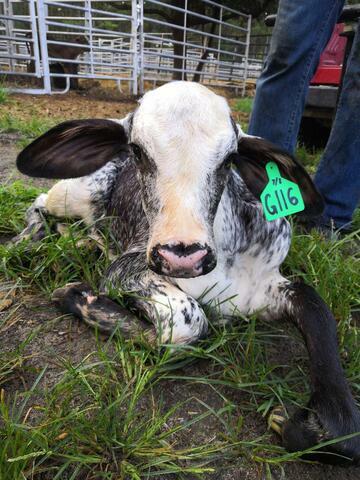



Genetic improvements in indigenous breeds may deliver 20x more milk in Global South
Development of genetically improved tropical-adapted dairy cattle could bolster food securityEditor's note: Image above shows herd of quarter-Holstein, three-quarter-Gyr cattle.
University of Illinois Urbana-Champaign animal scientists are set to deliver a potential game changer for subsistence farmers in Tanzania: cows that produce up to 20 times the milk of indigenous breeds.
The effort, published in Animal Frontiers, marries the milk-producing prowess of Holsteins and Jerseys with the heat, drought, and disease-resistance of Gyrs, an indigenous cattle breed common in tropical countries. Five generations of crosses result in cattle capable of producing 10 liters of milk per day under typical Tanzanian management, blasting past the half-liter average yield of indigenous cattle.
After breeding the first of these calves in the US, project leader Matt Wheeler, professor in the Department of Animal Sciences in the College of Agricultural, Consumer and Environmental Sciences (ACES) at Illinois, is ready to bring embryos to Tanzania.
“High-yielding Girolandos — Holstein-Gyr crosses — are common in Brazil, but because of endemic diseases there, those cattle can’t be exported to most other countries,” Wheeler said. “We wanted to develop a high health-status herd in the US so we could export their genetics anywhere in the world.”
Wheeler’s team plans to implant 100 half-blood Holstein-Gyr or Jersey-Gyr embryos into indigenous cattle in two Tanzanian locations this March. The resulting calves will be inseminated through successive generations to create “pure synthetic” cattle with five-eighths Holstein or Jersey and three-eighths Gyr genetics. Unlike Girolandos, Jersey-Gyr pure synthetics do not yet have an official name.

Pure synthetics are worth the time and effort; once the five-eighths/three-eighths genetics are established, they’re locked in. In other words, calves from successive matings will maintain the same genetic ratio.
“The whole idea is to keep the disease and pest resistance linked together with the milk production so that as you breed, those traits don’t separate,” Wheeler said. “That's going to be the challenge in developing countries; until you get to the pure synthetic generation, there will always be the temptation to breed to the bull down the road, losing the effect.”
Wheeler’s team, including coauthor Moses Ole-Neselle of the Food and Agriculture Organization of the United Nations (FAO), cares about getting this effort right. Although developing the embryos took years of meticulous work, they’re not stopping there. The team hosted its first online course on bovine assisted reproduction technology last summer, including 12 participants from Tanzania. And there’s more to come.
“It was important to start training the first group of veterinarians and graduate students to adopt the technology, so when we get there, it's not a foreign thing,” Wheeler said. “The Tanzanian government wants this training and student exchanges. We’re going to continue investing in this program for as long as it takes.”
Wheeler recognizes the best genetics and most comprehensive training won’t amount to much if the plan doesn’t account for the local culture. With advice from collaborators like the Tanzania Livestock Research Institute and Teresa Barnes, director of the Center for African Studies at Illinois, Wheeler has already adjusted his strategy to accommodate the preferences of local Maasai herdsmen.
“We’ve learned some Maasai clans strongly prefer smaller, red cattle, so the Holstein crosses we made initially, which were large and black, weren’t going to work,” he said. “I had to start over with Jerseys, which set us back a bit. It will be worth it if they’re better accepted.”
But some aspects of Tanzanian cattle management will have to change to realize the full potential of the improved genetics. For example, Wheeler said nomadic Maasai herders often graze cattle 25 miles from their enclosures each day, limiting the energy available for milk production.
While the project is still in its early stages, it represents a step toward more climate-resilient animal agriculture, the topic of the special issue of Animal Frontiers in which Wheeler’s article is published. While Wheeler’s current priority is to bolster food security in the Global South where climate change is hitting hardest, he said the same technology could be used to protect cattle from changing climates here in the US and around the world. In other words, tropical genetics could be inserted into our already high-yielding cattle to better withstand heat, drought, and disease.
“These cattle would work very well in Mexico, Texas, New Mexico, and California. Maybe it's time to start thinking about that now,” Wheeler said. “People don't usually think that far ahead, but my prediction is that people are going to look back and realize having tropical genetics earlier would have been a good thing.”
The study, “Development of genetically improved tropical-adapted dairy cattle,” is published in Animal Frontiers. Authors include Paula Marchioretto, Chanaka Rabel, Crystal Allen, Moses Ole-Neselle, and Matthew B. Wheeler. This work was partially supported by the USDA Multistate Project W-4171, the ACES Office of International Programs, the University of Illinois National Resource Center in African Studies via funding through the Department of Education’s Title VI grant program for 2022-26 and the Ross Foundation (Agreement #635148).


